MATHEMATICS 177 CHESS
Endgames without pieces |
|
THE OPPOSITION. This term is applied to chess positions in which only pawns
and the two kings remain.
| Definition 1: |
In either of the two positions at the right, whichever player has
just finished moving
HAS THE OPPOSITION. |
|
|
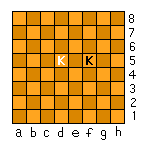 |
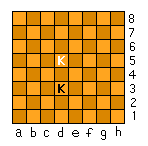 |
| Figure 1 |
Figure 2 |
|
| Definition 2: |
|
Let N be the smallest number of moves it would take the white
king to reach a position like Figure 1 or figure 2 above, with
the black king remaining stationary. If N is even, and white
has just finished moving, then white has the DISTANT OPPOSITION
(or POTENTIAL OPPOSITION); otherwise, black has the distant opposition.
In figures 3, 4, and 5 below, whichever player moves SECOND
has the distant (or potential) opposition. |
|
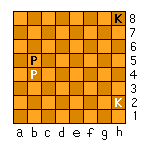 |
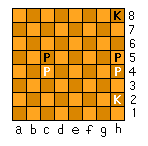 |
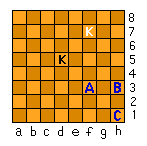 |
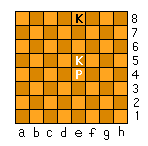 |
| Figure 3 |
Figure 4 |
Figure 5 |
Figure 6 |
|
If black moves first, white captures black pawn, but the
game is drawn since black gains the opposition at the capture |
|
|
Who wins if black moves first? Who wins if white moves first? |
|
|
The two kings, and squares A and C, are in distant opposition. |
|
|
If white moves first, white wins. If black moves first, the game is drawn. |
|
The opposition, or distant/potential opposition, are strategic prizes which
you may keep as long as you like, but can give up at any moment, usually in
exchange for the queening of one of your pawns. If you give up your opposition,
be sure you have compensation in hand, sinceyour opponent need never give
the opposition back to you! With correct play, distant opposition can usually be
transformed into actual opposition, depending upon the placement of pawns.
The position of the pawns , either your own pawns or your opponent's, may either
prevent your attaining the opposition, or prevent your using it once you have
attained it (as in Figure 3). The opposition is a particularly mysterious
asset: endgames are often won or lost because of it, sometimes with the
players unaware of it's role in their game. The opposition is valuable
because with it's help, you may force your opponent's king away from a
pawn it is guarding, allowing you to capture it. Or you may force your
opponent's king away from the queening square for one of your pawns,
allowing your pawn to become a queen (as in Figure 6).
Defensively, you may use opposition to prevent an enemy pawn from queening,
as in Figure 6 also, thereby forcing a draw.
 |
|
 |
This page last updated
16 March 2004 |
|







